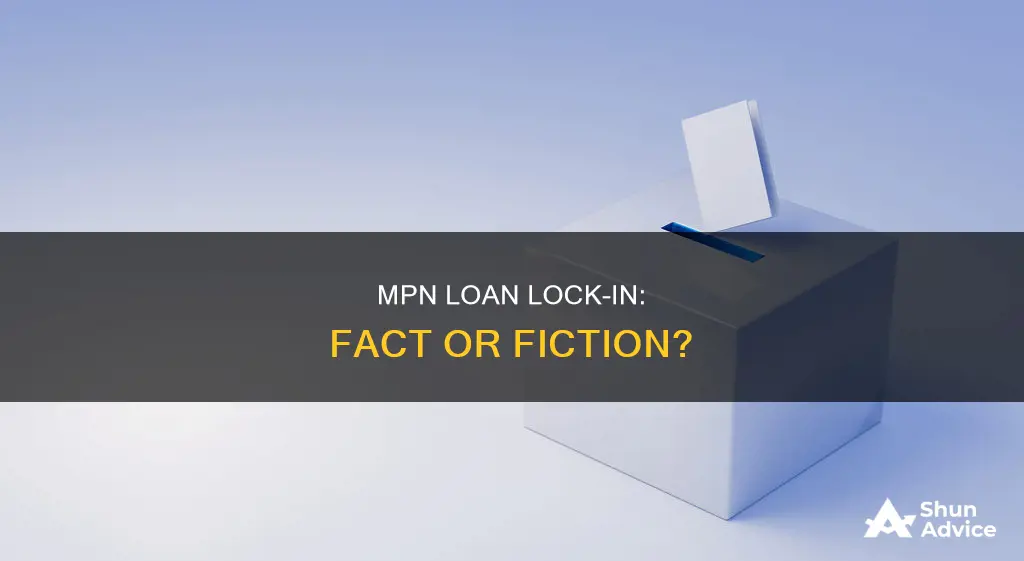
A Master Promissory Note (MPN) is a legal document that outlines the terms and conditions of a federal student loan. It is a commitment to repay your loan and any interest and fees, even if you do not complete your degree. It is not optional and is required to receive federal student loans. Signing an MPN is one of the final steps before receiving financial aid funds. It is valid for up to 10 years and covers multiple loans, so you don't need to sign a new one each year. However, it is important to understand the terms and conditions outlined in the MPN to avoid defaulting on your loan and facing serious financial consequences.
| Characteristics | Values |
|---|---|
| Required? | Yes, if you need to accept federal student loans. |
| Purpose | To assure you understand that federal loans must be repaid. |
| Validity | Up to 10 years at your school. |
| Number of MPNs required | One for all federal student loans while in school, provided enrollment is continuous. |
| Types of MPNs | For undergraduate students, graduate students, and Parent PLUS loans. |
| Interest rates | Not included in the MPN as rates change annually. |
| Consequences of violating terms | Defaulting on loans, wage garnishment, damaged credit, and loss of eligibility for future aid. |
| Entrance counseling | May be required after signing the MPN to learn about rights and responsibilities. |
What You'll Learn

Master Promissory Note (MPN) is a contract
A Master Promissory Note (MPN) is a contract between an individual and the government, outlining the terms and conditions of federal student loans. It is a legally binding agreement that commits the borrower to repay their debt, with the loan funds being used exclusively for authorised academic expenses. The MPN is not optional and is required to receive federal student loans. It is important to understand the obligations and ramifications of defaulting on the loan, as outlined in the MPN, to avoid serious financial consequences.
The MPN is a long-term commitment that covers multiple loans over potentially many years. It is not limited to a single loan but extends to any subsequent loans taken out after the first one. This means that if an individual violates the terms of their MPN, they risk defaulting on all their loans, which can lead to wage garnishment, damaged credit, and loss of eligibility for future federal student aid. It is worth noting that interest rates on loans are not included in the MPN as these rates change annually, and each federal loan has a fixed rate for the life of the loan.
There are three types of MPNs: one for undergraduate students, one for graduate students, and one for Parent PLUS loans. The completion of an MPN is typically done through a federal online portal, and it only needs to be filled out once, covering all federal student loans during an individual's continuous enrolment in school. It is important to note that the MPN is not a commitment to taking out loans but rather an assurance that if an individual borrows federal loans, they understand and agree to repay them.
The MPN is a critical step in the financial aid process, and it is recommended that individuals thoroughly understand the terms and conditions before signing. While it may seem like a daunting commitment, it is a necessary step to access federal student loans, and individuals should carefully consider their financial options and obligations before proceeding.
Clay Loan's Porosity: A Comprehensive Overview
You may want to see also

MPN is required to receive federal student loans
Completing a Master Promissory Note (MPN) is a crucial step in the process of securing federal student loans. The MPN serves as a contract and outlines the terms and conditions of the loan, as well as the responsibilities of the borrower. It is a commitment that ensures borrowers understand their obligation to repay any federal loans they take out.
The MPN is a requirement for anyone seeking federal student loans. It is a legally binding document that outlines the rights and responsibilities of both the borrower and the lender. By signing the MPN, borrowers agree to the terms and conditions of the loan, including the repayment schedule and any applicable fees or penalties. It is important to carefully review the MPN before signing to fully understand the obligations and commitments involved.
The MPN covers multiple years of borrowing, typically up to 10 years of continuous enrollment at a specific college or university. This means that students do not need to sign a new MPN each year. Instead, they accept the amount of each year's new loans under the terms of the existing MPN. This simplifies the process and ensures that students do not have to go through the same paperwork annually.
There are three types of MPNs: one for undergraduate students, one for graduate students, and one for Parent PLUS loans. The differences between them are minimal, primarily involving different forms and active annual confirmation for Parent PLUS loans. The MPN is typically completed on a federal online portal, where borrowers provide contact information, select the schools they want to send the MPN to, and provide two references for potential future contact.
While completing the MPN is a necessary step in the federal student loan process, it is important to understand that it does not lock borrowers into their loans. The MPN is a commitment to repay any federal loans borrowed, but borrowers have the right to refuse the loan funds if they change their minds. However, once the loan funds are accepted, borrowers are responsible for repaying them according to the terms outlined in the MPN.
Chase College Loans: What You Need to Know
You may want to see also

MPN is not optional
Completing a Master Promissory Note (MPN) is a crucial step in the process of obtaining federal student loans. While it might seem like a mere formality, signing an MPN has significant implications and is not something to be taken lightly.
First and foremost, it is important to understand that an MPN is a legally binding agreement between the borrower and the government. By signing the MPN, the borrower is making a commitment to repay the loan according to the agreed-upon terms and conditions. This means that even if a borrower does not complete their degree or fails to find a job in their field, they are still obligated to repay the loan, along with any interest and fees that may accrue.
The MPN is not optional because it serves as a protective measure for both the borrower and the lender. It clearly outlines the obligations of each party, ensuring that everyone understands the terms of the loan. This transparency helps to prevent misunderstandings or disputes down the line. Additionally, the MPN covers multiple loans over an extended period, which means that borrowers do not need to sign a new MPN for each individual loan they take out while in school.
Furthermore, the MPN is a prerequisite for receiving federal student loans. It is one of the final steps in the financial aid process, and without it, borrowers will not have access to the funds they need to pay for their education. For this reason, it is essential that borrowers thoroughly understand the implications of signing an MPN and only do so if they fully intend to borrow federal loans.
While the MPN itself is non-negotiable, borrowers do have some agency in the process. For instance, borrowers can choose to fill out the MPN on the Federal Student Aid website or submit a hard copy. Additionally, they can select the schools that will receive the MPN and provide contact information and references. However, once the MPN is signed, borrowers are locked into the agreement, and any violation of its terms can result in serious financial consequences, including wage garnishment, damaged credit, and loss of eligibility for future aid.
Community College and Loan Deferment: What's the Verdict?
You may want to see also

MPN covers multiple loans
Completing a Master Promissory Note (MPN) is a requirement for taking out federal student loans. An MPN is a legal document that outlines the terms and conditions of your loan, including interest rates, fees, repayment plans, and borrower rights and responsibilities. It is a promise to pay back the loan, with interest, according to the agreed-upon terms.
The FAFSA MPN is specifically for undergraduate students seeking a direct subsidized or unsubsidized loan from the Department of Education (DOE). A direct subsidized loan covers the interest payments while the student is in college, whereas a direct unsubsidized loan does not. The FAFSA PLUS MPN, on the other hand, is for graduate students or parents of students seeking a Direct PLUS loan to cover expenses not met by their financial aid.
Importantly, an MPN covers multiple loans. This means that instead of signing a new MPN for each loan, the first MPN you sign will usually cover all subsequent loans. This simplifies the process, as you won't need to complete a new MPN each time you take out a new loan. However, some schools may require an additional step of filling out an MPN annually before funding your loans. Therefore, it is advisable to contact your school's financial aid office to understand their specific requirements.
While an MPN covers multiple loans, it is important to note that it is not a requirement if you do not plan on taking out any loans. If you are unsure about your financial aid package and whether you will need loans, it is recommended to consult with your school's financial aid department to discuss your options and determine if completing an MPN is necessary.
Criminal Activity: Impact on Loan Scores and Financial Future
You may want to see also

MPN is a long-term commitment
A Master Promissory Note (MPN) is a long-term commitment that should not be taken lightly. It is a legally binding agreement between the borrower and the government, outlining the terms and conditions of federal student loans. This means that by signing an MPN, you are committing to repay your student loan debt, even if your circumstances change.
The MPN is not a document to be entered into lightly. It is a long-term commitment that covers multiple loans over many years. It is important to understand that the MPN is not just for one loan but for any subsequent loans taken out after the first one. This means that if you sign an MPN and take out a federal student loan, you are committing to repay that loan and any other federal student loans you may take out in the future.
The MPN is also a long-term commitment in the sense that it can be valid for up to 10 years at your school. This means that you don't need to sign a new MPN for each school year, and the document can cover multiple loans over an extended period. Additionally, the interest rates on your loans won't appear in your MPN as rates change annually, but your rate will be locked in for the life of your loan.
It is important to carefully consider your financial situation and future prospects before signing an MPN. While it is a necessary step to receive federal student loans, it is a serious commitment that should not be taken lightly. Defaulting on your loans can have serious financial ramifications, including wage garnishment, damaged credit, and loss of eligibility for future aid.
Chase Small Loans: What You Need to Know
You may want to see also
Frequently asked questions
MPN stands for Master Promissory Note. It is a legal document that outlines the terms and conditions of your federal student loans.
No, you only need to fill out one MPN for all the federal student loans you take out while you're in school, provided your enrollment is continuous.
Violating the terms of the MPN can lead to defaulting on your loans, which can result in wage garnishment, damaged credit, and loss of eligibility for future aid.
No, you cannot make changes to the MPN. However, you can contact your loan servicer if your situation changes after signing to discuss your options.







